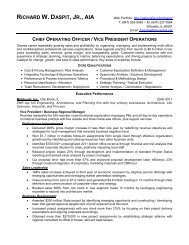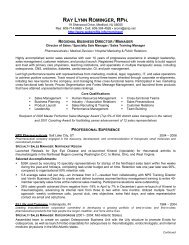The Art of Practical and Precise Strain Based ... - Webprofile.info
The Art of Practical and Precise Strain Based ... - Webprofile.info
The Art of Practical and Precise Strain Based ... - Webprofile.info
- No tags were found...
You also want an ePaper? Increase the reach of your titles
YUMPU automatically turns print PDFs into web optimized ePapers that Google loves.
<strong>Strain</strong>-<strong>Based</strong> Measurement Introduction:Applications Note 1-9:<strong>The</strong> Second-Order SystemAn accelerometer having an internal spring member that responded to accelerationinputs in two or more dimensions simultaneously would be <strong>of</strong> little use aswe would be unable to define a dimension that produced any given response.This is why an accelerometer spring member is designed to be flexible(responsive) in one dimension <strong>and</strong> stiff (unresponsive) in all other dimensions.Our goal would be to define the measurement axis precisely to produce a single-degree-<strong>of</strong>-freedomstructure. <strong>The</strong> single-degree-<strong>of</strong>-freedom spring-member-basedsensor class invariably show second-order responses.It should be noted that no mechanical system is able to perfectly imitatethe single-degree-<strong>of</strong>-freedom system <strong>and</strong> will simultaneously supportmotion, to some extent, in other dimensions. Even well-designed sensorstructures will show some degree <strong>of</strong> ÒtransverseÓ responsivity. <strong>The</strong>second-order system is defined as a system where the transfer functionis the solution to a second-order differential equation. <strong>The</strong> second-orderresponse defines the response <strong>of</strong> any mechanical system possessingmass, where the restoring forces acting upon this mass are provided bya spring constant, <strong>and</strong> resistance to motion is provided by mechanicaldamping. <strong>The</strong> spring constant is quantified by the stiffness <strong>of</strong> the springmember. <strong>The</strong> damping forces acting upon the mass may result from theintrinsic structural damping <strong>of</strong> the material that comprises the springmember, or may derive from fluidic- or gas-damping provided in thesensor design. In the case <strong>of</strong> the piezoelectric element, the spring rate<strong>of</strong> the piezoelectric element is high <strong>and</strong> the internal structural damping<strong>of</strong> the element is low yielding a close-to-zero-damped second-orderresponse. In the case <strong>of</strong> the seismometer, the spring restoring forces aregenerally provided by discrete spring elements <strong>of</strong> relatively low springrate, yielding fundamentally low resonance frequencies.CHAPTER 1-50 <strong>The</strong> <strong>Art</strong> <strong>of</strong> <strong>Practical</strong> <strong>and</strong> <strong>Precise</strong> <strong>Strain</strong> <strong>Based</strong> Measurement 2nd Edition © 1999
















